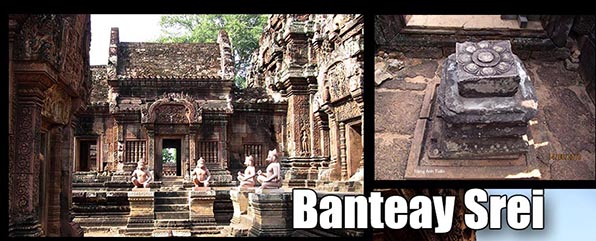Banteay Srei, một viên ngọc của nghệ thuật Khơ Me
English version
Version française
Nằm cách Angkor 20 cây số về phía đông bắc và gần dưới chân núi Phnom Kulên, ngôi đền này được xây dựng vào thế kỷ thứ 10 bằng sa thạch màu hồng và đá ong ở triều đại của Jayavarman V. Đây là công trình của một người đạo Bà La môn tên là Yajnavaraha. Ông nầy là cố vấn của vua Rajendravarman và sau đó là thái phó của Jayavarman V. Ngoài sự đa dạng của đá sa thạch (chất liệu yêu thích của người Khơ Me) với sắc màu hồng ấm áp, phẩm chất và vẻ đẹp của ngôi đền này được tìm thấy nhờ sự tao nhã đặc biệt ở nơi các tác phẩm điêu khắc và vẻ màu tươi tắn của các vật trang trí thanh tao. Ngôi đền này đổi màu suốt cả ngày với ánh nắng mặt trời.
Đền nầy được người Pháp phát hiện vào năm 1914. Nó trở nên nổi tiếng vào năm 1923 khi nhà văn André Malraux bị bắt vì tội che giấu 4 apsara. Ngôi đền này được gần đây có một cái tên có nghĩa là « thành của phụ nữ » được viện dẫn đến sự tinh tế của các đồ trang trí chạm khắc mà chỉ có thể được thực hiện bởi các phụ nữ hoặc kích thước của đền rất nhỏ so với các ngôi đền khác. Việc phục hồi được thực hiện xuất sắc bởi ông Henri Marchal trong khoảng thời gian từ 1931 đến 1936 bằng cách sử dụng phương pháp sùng tu « anastylose » mà được người Hà Lan áp dụng.
© Đặng Anh Tuấn
Situé à 20 km au nord-est d’Angkor et presqu’au pied du mont Phnom Kulên, ce temple fut construit au X ème siècle dans du grès rose et de la latérite sous le règne de Jayavarman V. C’est l’oeuvre d’un certain brahmane Yajnavaraha, conseiller du roi Rajendravarman puis gourou de Jayavarman V. Outre la variété de grès (matériau de prédilection des Khmers) aux chaudes tonalités de rose, la qualité et la beauté de ce temple se retrouvent dans la finesse exceptionnelle des sculptures et la fraîcheur de ses décorations raffinées. Ce temple change de couleur au fil de la journée suivant l’ensoleillement.
Il fut découvert par les Français en 1914. Il devint célèbre en 1923 lorsque l’écrivain André Malraux a été arrêté pour la dissimulation de 4 apsaras. On donne à ce temple une appellation récente signifiant « citadelle des femmes » en référence à la délicatesse des décorations sculptées qui n’auraient pu être faites que par des femmes ou à sa petite taille par rapport aux autres temples. La restauration fut effectuée par Henri Marchal entre 1931 et 1936 d’une manière remarquable en se servant de l’anastylose adoptée par les Hollandais.
Un joyau de l’art khmer
Located 20 km northeast of Angkor and almost at the foot of mount Phnom Kulên, this temple was built in the Xth century in pink sandstone and laterite under the Jayavarman V reign. It is the work of king Rajendravarman‘s adviser, a certain Brahman Yajnavaraha and guru of Jayavarman V. Besides the variety of stoneware (preferred material of the Khmers) in the warm tones of pink, the quality and beauty of this temple are found in the exceptional delicacy of sculptures and the freshness of its sophisticated decorations. Depending on the period of sunshine, this temple changes colour through the day.
It was discovered by the French people in 1914. It became famous in 1923 when French writer André Malraux was arrested for dissimulating 4 apsaras. One gives to this temple a recent appelation naming ” citadel of women ” in reference to the delicacy of the sculptured decorations that could have been made only by women or its small size compared with other temples. The restoration was made by Henri Marchal between 1931 and 1936 in a remarkable way by using the technique of anastylosis adopted by Dutch people.

